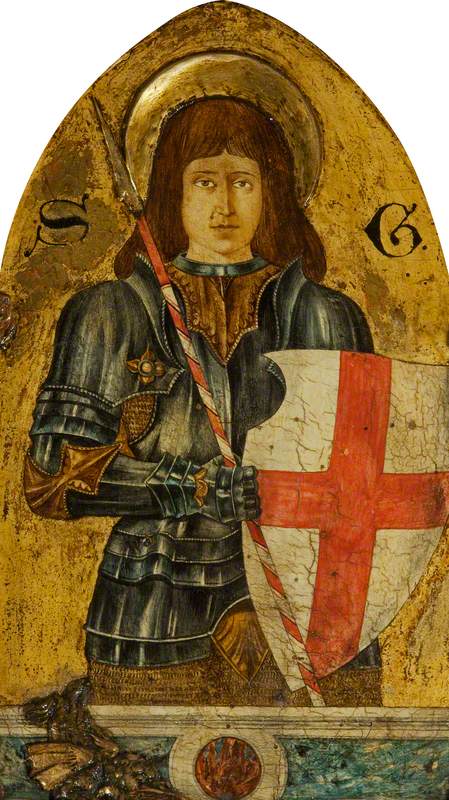George (Georgios) was probably a Roman soldier of Greek-speaking origin living in Palestine at the beginning of the fourth century. He is held to have been martyred at Lydda around the year 304, at the beginning of the great persecution of Christians under the emperor Diocletian. He became known throughout the East as Megalomartyr, the “Great Martyr.” Devotion to him was widespread in both western and eastern reaches of the Roman Empire by the fifth century, and he occurs in the Martyrology of Jerome, a pseudepigraphal text attributed to Jerome of Jerusalem that originated in the mid-fifth century; and in the Gregorian Sacramentary, a tenth-century text.
The famous story of his slaying the dragon is possibly due to his being mistaken in iconography for the Archangel Michael, both of them usually being depicted as wearing armor. There may also have been a conflation of George with the pagan Greek hero Perseus, who slew a sea monster that menaced Andromeda, a myth associated with the region of Lydda. According to the story of Saint George and the Dragon in the Golden Legend (a mid-thirteenth century text), George defeated a dragon that had been terrorizing the countryside, poisoning with its breath all who approached it. He then led the captive dragon before the people, telling them that if that would believe in Jesus Christ and be baptized, he would rid them of the monster. The king and people agreed, George slew the dragon, and 15,000 persons were baptized. George took no reward but asked instead the king’s surety that he would maintain churches, honor presbyters, and show compassion to the poor. The Legend continues with an account of the sufferings and death of George, this being the only historical element in the text.
A number of churches in England were dedicated to George prior to the Norman Conquest, and he is found in the Martyrology of Bede and the Old English Martyrology. He is also recorded in the Irish Martyrology of Oengus. English devotion to Saint George grew during the Crusades, in part due to a vision of Saints George and Demetrius at the siege of Antioch that preceded the defeat of the Saracens and the fall of the city to the crusaders in the First Crusade. The author of the Gesta Francorum claimed that George’s body was in a church near Ramleh. King Richard the First (Lionheart) placed himself and his army under George’s protection, a synod at Oxford in 1222 made his feast a lesser holiday, and King Edward the Third founded the Order of the Garter under Saint George’s patronage. The Chapel of Saint George was built at Windsor Castle for the Order by King Edward the Fourth and enlarged by King Henry the Seventh, and it remains the chapel for the royal family of the United Kingdom when they are in residence at Windsor, serving as well as the burial place for many members of English and British royalty. In 1415 the archbishop of Canterbury had George’s feast raised to one of the principal feasts of the year after the battle of Agincourt, when King Henry the Fifth in a speech made famous by Shakespeare invoked Saint George as England’s patron, George eventually displacing both Edward the Confessor and Edmund of East Anglia as England’s patron saint.
George came to be seen as the personification of the ideals of Christian chivalry, and by the late Middle Ages he was the patron not only of England but of Venice, Genoa, Portugal, and Catalonia. The sanctoral calendar in the Book of Common Prayer (2019) of the Anglican Church in North America is the first American sanctoral calendar to include George.
prepared from material in The Oxford Dictionary of Saints and Celebrating the Saints
The Collect
Almighty God, you gave your servant George boldness to confess the Name of our Savior Jesus Christ before the rulers of this world, and courage to die for this faith: Grant that we may always be ready to give a reason for the hope that is in us, and to suffer gladly for the sake of our Lord Jesus Christ; who lives and reigns with you and the Holy Spirit, one God, for ever and ever. Amen.

